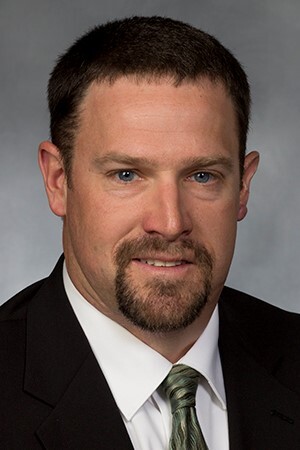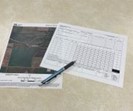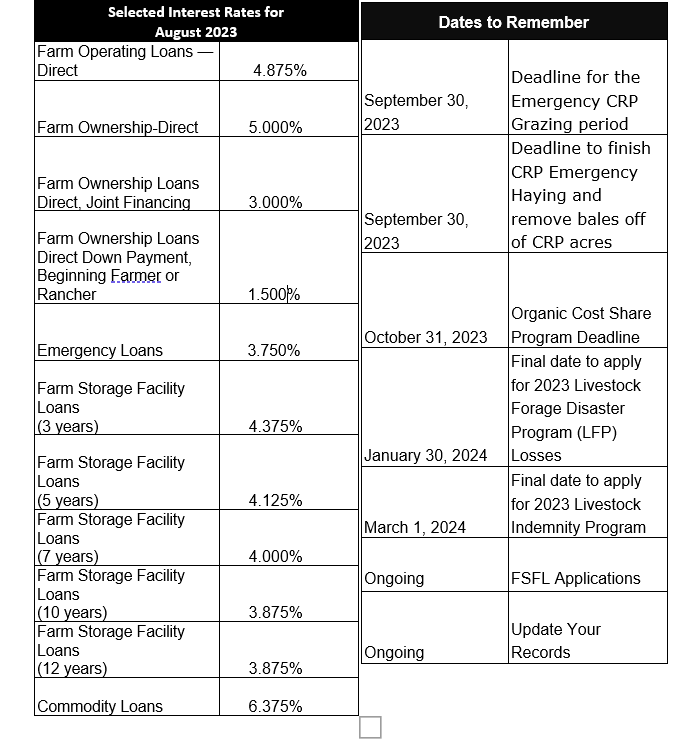In This Issue:

As I look back a few months, I cannot help but think – Life is moving very, very quickly.
Summer is nearly over and Fall of 2023 is just around the corner. It seems like we were just attending High School graduations and gearing up for county fair livestock exhibiting a mere few weeks ago. As I reflect on what has happened in what seems to be just a blink of an eye, I am amazed that:
Sweet corn harvest has come and went.
County fairs have come and went.
Summer vacation from school has come and went.
Summer baseball/softball season has come and went.
State Fair has come and went.
In a little over 2 months, we will be saying the 2023 Harvest has come and went.
Time seems to whirl by one season at a time, picking up speed as it goes.
The spring and summer months have had many challenging situations, lack of rainfall just to mention one, as it threw Illinois into a drought condition state. August 2nd was a relief for many as haying and grazing CRP acres began, in hopes to assist producers with feeding their livestock, after many months of extreme dry conditions. Many producers requested approval to hay or graze their CRP acres.
Again, this year the weather for the Illinois State Fair was almost perfect, mild and low humidity during the days with cool nights and some rain to help settle the dust. It was great to attend the FSA BBQ again this year and see so many familiar faces, while meeting new ones and sharing a meal with all the current and retired FSA employees and special guests.
I would like to thank Illinois Department of Agriculture (IDOA) Director Jerry Costello for his hospitality during the BBQ as well as throughout the entire state fair. Director Costello and his state fair staff have welcomed FSA into the IDOA tent for many, many years, allowing us to market and explain FSA programs and loans to fair participants. I would also like to thank the Illinois Specialty Growers Association and Raghela Scavuzzo for their everlasting Urban Ag partnership with FSA. Together we can do great things for many urban growers as we assist them with their new or existing agriculture ventures. I would also like to thank the FSA employees and many others that took the time to stop and introduce themselves to me while at the State Fair. It’s great to make those connections, and it means a lot to me when you take the time to stop and visit.
I have a few deadlines and reminders this month.
September 30, 2023 - Deadline to finish CRP Emergency Haying and remove bales off of CRP acres
September 30, 2023 – Deadline for the Emergency CRP Grazing period
As we move on into the months of the 2023 fall harvest, I ask that you take some time every day to slow down and take a short break, get a cold drink/snack or just rest and regroup. Those 15 minutes that you take a break each day, could mean all the difference in the world, to you staying safe on and around the farm.
I wish you all a successful and safe harvest season.
Sincerely,
Scott Halpin
State Executive Director
Illinois Farm Service Agency
|
U.S. Department of Agriculture (USDA) Farm Service Agency (FSA) State Executive Director, Scott Halpin, announced that 89 counties are authorized for emergency haying and grazing of Conservation Reserve Program (CRP) acres for fiscal year 2023. FSA’s fiscal year runs from October 1 to September 30.
Beginning August 2, 2023, Adams; Alexander; Bond; Boone; Brown; Bureau; Calhoun; Carroll; Cass; Champaign; Christian; Clark; Clinton; Coles; Cook; Crawford; Cumberland; Dewitt; Dekalb; Douglas; DuPage; Edgar; Effingham; Ford; Franklin; Fulton; Greene; Grundy; Hancock; Hardin; Henderson; Henry; Iroquois; Jackson; Jasper; Jefferson; Jersey; JoDaviess; Johnson; Kane; Kankakee; Kendall; Knox; LaSalle; Lake; Lee; Livingston; Logan; Macon; Madison; Marion; Marshall; Mason; Massac; McDonough; McHenry; McLean; Menard; Mercer; Monroe; Morgan; Moultrie; Ogle; Peoria; Perry; Piatt; Pike; Pope; Pulaski; Putnam; Randolph; Rock Island; St. Clair; Sangamon; Schuyler; Scott; Shelby; Stark; Stephenson; Tazewell; Union; Vermilion; Warren; Washington; Whiteside; Will; Williamson; Winnebago and Woodford counties will be eligible for emergency haying and grazing. The emergency grazing period will begin on August 2, 2023 and end on September 30, 2023. The emergency haying authorization for these counties will begin on August 2, 2023 and end on September 30, 2023. An additional 5 counties have been added to the original authorized counties and they are, Clay; Fayette;
Hamilton; Richland and Saline.
Counties become eligible for CRP emergency haying and grazing when they reach the D2 (severe drought) level on the U.S. Drought Monitor for at least one week and are outside of the primary nesting season (April 15th through August 1st.) Additionally, the 2018 farm bill authorized counties with a documented 40-percent loss of forage production to be eligible for emergency grazing and haying. Local FSA County Committees can review forage loss data and make a recommendation to the Illinois FSA State Committee to authorize emergency haying and grazing outside the primary nesting season.
Eligible producers who are interested in emergency haying and grazing CRP acres must request approval before haying and grazing eligible acreage and must obtain a modified conservation plan from the Natural Resources Conservation Service (NRCS) that includes haying and grazing provisions.
All practices for emergency haying and grazing are eligible except CP38 (SAFE) and Conservation Reserve Enhancement (CREP) acres. There will be no CRP annual rental payment reduction for 2023 emergency haying and grazing authorizations.
To take advantage of the emergency haying or grazing provisions, authorized producers can use the CRP acreage for their own livestock or may grant another livestock producer use of the CRP acreage. Participants are limited to one hay cutting and are permitted to sell the hay.
In counties that are authorized for emergency haying and grazing, producers are reminded that the same CRP acreage cannot be both hayed and/or grazed at the same time. The eligible CRP acreage is limited to acres located within the approved county.
For more information and to request approval for emergency haying and grazing use of CRP acres, contact your local county FSA office.

-
Farmers and ranchers are facing natural disasters in many parts of the nation causing catastrophic damage to crops. Concerns have been expressed about the requirement to pay crop insurance premiums timely to avoid accrual of interest.
The Common Crop Insurance Policy, Area Risk Protection Insurance Policy, Rainfall Index Plan Common Policy, Whole-Farm Revenue Protection Pilot Policy, and Livestock policies’ Basic Provisions state that interest will accrue starting the first day of the month, following issuance of the notice of premium due by the Approved Insurance Provider (AIP), provided that a minimum of 30 days has passed from the premium billing date.
The Risk Management Agency (RMA) recognizes the challenges America’s farmers and ranchers face in light of these natural disasters and will provide flexibilities to help farmers and ranchers throughout these challenging times.
-
AIPs are authorized to provide additional time for policyholders to make payment of premium and administrative fees. Interest accrual on premium payments and administrative fees, as noted above, will be waived to the earliest of an additional 60 days of the scheduled payment due date or the termination date on policies with premium billing dates between July 1, 2023, and September 30, 2023. AIPs will begin to accrue interest after this additional period for unpaid premium and administrative fees. AIPs should promptly notify potentially affected policyholders of said relief.
To assist the AIPs and provide relief from the requirements of the Standard Reinsurance Agreement and Livestock Price Reinsurance Agreement that all uncollected premium be paid to the Federal Crop Insurance Corporation, RMA will also defer collection of any unpaid producer premium and administrative fees and waive all associated interest from AIPs accordingly beginning with the August monthly accounting reports.
AIPs are also authorized to provide additional time for policyholders to make payment for Written Payment Agreements due between July 1, 2023, and September 30, 2023.
Payments may be extended up to 60 days of the scheduled payment due date and considered a timely payment. Such extension of time will not be considered a modification of the Written Payment Agreement, and the AIP may waive any additional interest for the payment during this 60-day period.
|

USDA’s Farm Service Agency (FSA) has implemented pre-authorized debit (PAD) for Farm Loan Program (FLP) borrowers. PAD is a voluntary and alternative method for making weekly, bi-weekly, monthly, quarterly, semi-annual or annual payments on loans.
PAD payments are pre-authorized transactions that allow the National Financial and Accounting Operations Center (NFAOC) to electronically collect loan payments from a customer’s account at a financial institution.
PAD may be useful if you use nonfarm income from regular wages or salary to make payments on loans or adjustment offers or for payments from seasonal produce stands. PAD can only be established for future payments.
To request PAD, customers, along with their financial institution, must fill out form RD 3550-28. This form has no expiration date, but a separate form RD 3550-28 must be completed for each loan to which payments are to be applied. A fillable form can be accessed on the USDA Rural Development (RD) website at rd.usda.gov/publications/regulations-guidelines. Click forms and search for “Form 3550-28.”
If you have a “filter” on the account at your financial institution, you will need to provide the financial institution with the following information: Origination ID: 1220040804, Agency Name: USDA RD DCFO.
PAD is offered by FSA at no cost. Check with your financial institution to discuss any potential cost. Preauthorized debit has no expiration date, but you can cancel at any time by submitting a written request to your local FSA office. If a preauthorized debit agreement receives three payment rejections within a three-month period, the preauthorized debit agreement will be cancelled by FSA. The payment amount and due date of your loan is not affected by a cancellation of preauthorized debit. You are responsible to ensure your full payment is made by the due date.
For more information about PAD, contact your local County USDA Service Center or visit fsa.usda.gov.
|
Producers in Adams, Hancock, Pike, Randolph, and Schuyler Counties are eligible to apply for 2023 Livestock Forage Disaster Program (LFP) benefits on native pasture, improved pasture, forage sorghum.
LFP provides compensation if you suffer grazing losses for covered livestock due to drought on privately owned or cash leased land or fire on federally managed land.
County committees can only accept LFP applications after notification is received by the National Office of qualifying drought or if a federal agency prohibits producers from grazing normal permitted livestock on federally managed lands due to qualifying fire. You must complete a CCC-853 and the required supporting documentation no later than January 30, 2024, for 2023 losses.
For additional Information about LFP, including eligible livestock and fire criteria, contact your local County USDA Service Center or visit fsa.usda.gov.

Farmers can use USDA farm ownership microloans to buy and improve property. These microloans are especially helpful to beginning or underserved farmers, U.S. veterans looking for a career in farming, and those who have small and mid-sized farming operations. Microloans have helped farmers and ranchers with operating costs, such as feed, fertilizer, tools, fencing, equipment, and living expenses since 2013.
Microloans can also help with farmland and building purchases and soil and water conservation improvements. FSA designed the expanded program to simplify the application process, expand eligibility requirements and expedite smaller real estate loans to help farmers strengthen their operations. Microloans provide up to $50,000 to qualified producers and can be issued to the applicant directly from the USDA Farm Service Agency (FSA).
To learn more about the FSA microloan program, contact your local County USDA Service Center or visit fsa.usda.gov/microloans.
|
If you’ve suffered above normal expenses for hauling feed or water to livestock or hauling livestock to forage/grazing acres due to the impacts of drought, you may be eligible for financial assistance through the Emergency Assistance for Livestock, Honey Bees, and Farm-Raised Fish Program (ELAP). The following Illinois counties have reached the D3 designation: Adams, Hancock, Pike, Randolph, and Schuyler.
For eligible producers in qualifying counties, ELAP provides financial assistance for:
- the transportation of water to livestock;
- the above normal cost of mileage for transporting feed to livestock,
- the above normal cost of transporting livestock to forage/grazing acres.*
*Hauling livestock one-way, one haul per animal reimbursement and no payment for “empty miles.”
Eligible livestock include cattle, buffalo, goats and sheep, among others, that are maintained for commercial use and located in a county where the qualifying drought conditions occur. A county must have had D2 severe drought intensity on the U.S. Drought Monitor for eight consecutive weeks during the normal grazing period, or D3 or D4 drought intensity at any time during the normal grazing period. Producers must have risk in both eligible livestock and eligible grazing land in an eligible county to qualify for ELAP assistance.
Water Transportation
For ELAP water transportation assistance, a producer must be transporting water to eligible livestock on eligible grazing land where the producer had adequate livestock watering systems or facilities in place before the drought occurred and where they do not normally require the transportation of water. Payments are for costs associated with personal labor, equipment, hired labor, equipment, and/or contracted water transportation fees. Cost of the water itself is not covered. The ELAP payment formula uses a national average price per gallon.
Above Normal Costs of Transporting Feed
ELAP provides financial assistance to livestock producers who incur above normal expenses for transporting feed to livestock during drought. The payment formula excludes the first 25 miles and any mileage over 1,000 miles. The reimbursement rate is 60% of the costs above what would normally have been incurred during the same time period in a normal (non-drought) year.
Above Normal Costs of Transporting Livestock to Forage/Grazing Acres
ELAP provides financial assistance to livestock producers who are hauling livestock to a new location for feed resources due to insufficient feed and/or grazing in drought-impacted areas. Please contact your county FSA office for additional details.
For calendar year 2022 forward, producers must submit a notice of loss to your local FSA office within 30 calendar days of when the loss is apparent; producers should contact their county FSA office as soon as the loss of water resources or feed resources are known. For ELAP eligibility, documentation of expenses is critical. Producers should maintain records and receipts associated with the costs of transporting water to eligible livestock, the costs of transporting feed to eligible livestock, and the costs of transporting eligible livestock to forage/grazing acres.
ELAP also offers assistance to producers impacted by wildfire. Contact your county FSA office for more information on ELAP resources for wildfire losses. In addition, beekeepers also can benefit from ELAP provisions and should contact their county FSA office within 15 calendar days of when a loss occurs or from when the loss is apparent.
For more information and additional eligibility requirements, contact your local County USDA Service Center or visit fsa.usda.gov.
The Livestock Indemnity Program (LIP) provides assistance to you for livestock deaths in excess of normal mortality caused by adverse weather, disease and attacks by animals reintroduced into the wild by the federal government or protected by federal law.
For disease losses, FSA county committees can accept veterinarian certifications that livestock deaths were directly related to adverse weather and unpreventable through good animal husbandry and management.
For 2023 livestock losses, you must file a notice within 30 calendar days of when the loss is first apparent. You then must provide the following supporting documentation to your local FSA office no later than 60 calendar days after the end of the calendar year in which the eligible loss condition occurred.
- Proof of death documentation
- Copy of grower’s contracts
- Proof of normal mortality documentation
USDA has established normal mortality rates for each type and weight range of eligible livestock, i.e. Adult Beef Cow = 1.5% and Non-Adult Beef Cattle (less than 250 pounds) = 5%. These established percentages reflect losses that are considered expected or typical under “normal” conditions.
In addition to filing a notice of loss, you must also submit an application for payment by March 1, 2024.
For more information, contact the your local County USDA Service Center or visit fsa.usda.gov.
The term “sodbusting” is used to identify the conversion of land from native vegetation to commodity crop production after December 23, 1985. As part of the conservation provisions of the Food Security Act of 1985, if you’re proposing to produce agricultural commodities (crops that require annual tillage including one pass planting operations and sugar cane) on land that has been determined highly erodible and that has no crop history prior to December 23, 1985, that land must be farmed in accordance with a conservation plan or system that ensures no substantial increase in soil erosion.
Eligibility for many USDA programs requires compliance with a conservation plan or system on highly erodible land (HEL) used for the production of agricultural commodities. This includes Farm Service Agency (FSA) loan, disaster assistance, safety net, price support, and conservation programs; Natural Resources Conservation Service (NRCS) conservation programs; and Risk Management Agency (RMA) Federal crop insurance.
Before you clear or prepare areas not presently under production for crops that require annual tillage, you are required to file Form AD-1026 “Highly Erodible Land Conservation and Wetland Conservation Certification,” with FSA indicating the area to be brought into production. The notification will be referred to NRCS to determine if the field is considered highly erodible land. If the field is considered HEL, you are required to implement a conservation plan or system that limits the erosion to the tolerable soil loss (T) for the predominant HEL soil on those fields.
In addition, prior to removing trees or conducting any other land manipulations that may affect wetlands, remember to update form AD-1026, to ensure you remain in compliance with the wetland conservation provisions.
Prior to purchasing or renting new cropland acres, it is recommended that you check with your local USDA Service Center to ensure your activities will be in compliance with the highly erodible land and wetland conservation provisions.
For additional information on highly erodible land conservation and wetland conservation compliance, contact your local USDA Service Center.
Bins are ideally designed to hold a level volume of grain. When bins are overfilled and grain is heaped up, airflow is hindered, and the chance of spoilage increases.
Producers who take out marketing assistance loans and use the farm-stored grain as collateral should remember that they are responsible for maintaining the quality of the grain through the term of the loan.
The USDA is taking additional steps as part of its commitment to strengthen the market for domestically grown organic goods, and to support producers seeking organic certification. These funding opportunities are part of the U.S. Department of Agriculture’s (USDA) Organic Transition Initiative, launched in fall 2022, which is a suite of offerings to help existing organic farmers and those transitioning to organic production and processing.
Consumer demand for organically produced goods surpassed $67 billion in 2022, and multi-year trends of strong growth in the sector provide market incentives for U.S. farmers across a broad range of products. However, through public comment and listening sessions USDA has heard that producers may be less willing to commit to the three-year transition to organic certification because of risks related to inadequate organic processing, storage, and handling capacity, cost barriers due to limited markets for rotational crops, a lack of certainty about market access, and insufficient supply of certain organic ingredients. The organic livestock and processed product markets depend heavily on imported agricultural products for feed grains and key ingredients. These are longstanding market issues that were brought into sharp focus due to the impacts of the pandemic and international conflicts in critical overseas organic supply regions, resulting in limitations on certain domestic organic products in the face of rising demand.
Cost Share for Organic Certification
As part of USDA’s broader effort to support organic producers and in response to stakeholder feedback, this year the Farm Service Agency increased the cost share amount under the Organic Certification Cost Share Program (OCCSP), which helps organic producers cover organic certification costs, to the maximum amount allowed by statute.
Specifically, FSA will cover up to 75% of costs associated with organic certification, up to $750 for crops, wild crops, livestock, processing/handling and state organic program fees (California only). OCCSP will cover costs incurred from October 1, 2022, through September 30, 2023.
FSA begins accepting applications for OCCSP Monday, May 15, 2023. Applications are due October 31, 2023. To apply, producers and handlers should contact the FSA at their local USDA Service Center. As part of completing the OCCSP application, producers and handlers will need to provide documentation of their organic certification and eligible expenses. Organic producers and handlers may also apply for OCCSP through participating state departments of agriculture.
FSA is also accepting applications from state departments of agriculture to administer OCCSP. FSA will post a synopsis of the funding opportunity on grants.gov and will send more information to all eligible state departments of agriculture. Additional details can be found on the OCCSP webpage. More information about these initiatives and more can be found at farmers.gov/organic-transition-initiative.

|